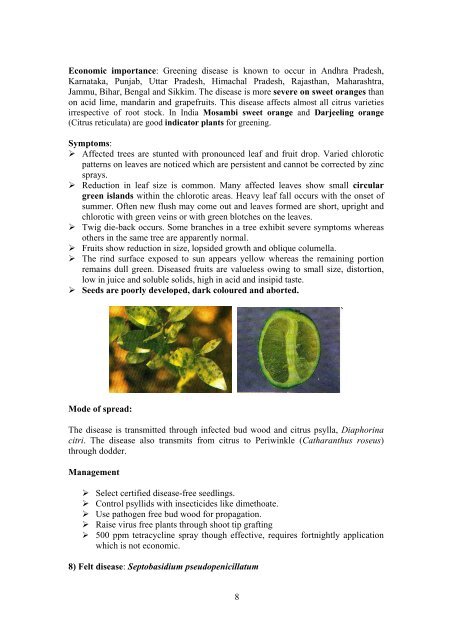PATH 372 Diseases of Horticultural Crops
PATH 372 Diseases of Horticultural Crops
PATH 372 Diseases of Horticultural Crops
You also want an ePaper? Increase the reach of your titles
YUMPU automatically turns print PDFs into web optimized ePapers that Google loves.
Economic importance: Greening disease is known to occur in Andhra Pradesh,<br />
Karnataka, Punjab, Uttar Pradesh, Himachal Pradesh, Rajasthan, Maharashtra,<br />
Jammu, Bihar, Bengal and Sikkim. The disease is more severe on sweet oranges than<br />
on acid lime, mandarin and grapefruits. This disease affects almost all citrus varieties<br />
irrespective <strong>of</strong> root stock. In India Mosambi sweet orange and Darjeeling orange<br />
(Citrus reticulata) are good indicator plants for greening.<br />
Symptoms:<br />
Affected trees are stunted with pronounced leaf and fruit drop. Varied chlorotic<br />
patterns on leaves are noticed which are persistent and cannot be corrected by zinc<br />
sprays.<br />
Reduction in leaf size is common. Many affected leaves show small circular<br />
green islands within the chlorotic areas. Heavy leaf fall occurs with the onset <strong>of</strong><br />
summer. Often new flush may come out and leaves formed are short, upright and<br />
chlorotic with green veins or with green blotches on the leaves.<br />
Twig die-back occurs. Some branches in a tree exhibit severe symptoms whereas<br />
others in the same tree are apparently normal.<br />
Fruits show reduction in size, lopsided growth and oblique columella.<br />
The rind surface exposed to sun appears yellow whereas the remaining portion<br />
remains dull green. Diseased fruits are valueless owing to small size, distortion,<br />
low in juice and soluble solids, high in acid and insipid taste.<br />
Seeds are poorly developed, dark coloured and aborted.<br />
Mode <strong>of</strong> spread:<br />
The disease is transmitted through infected bud wood and citrus psylla, Diaphorina<br />
citri. The disease also transmits from citrus to Periwinkle (Catharanthus roseus)<br />
through dodder.<br />
Management<br />
Select certified disease-free seedlings.<br />
Control psyllids with insecticides like dimethoate.<br />
Use pathogen free bud wood for propagation.<br />
Raise virus free plants through shoot tip grafting<br />
500 ppm tetracycline spray though effective, requires fortnightly application<br />
which is not economic.<br />
8) Felt disease: Septobasidium pseudopenicillatum<br />
8

















